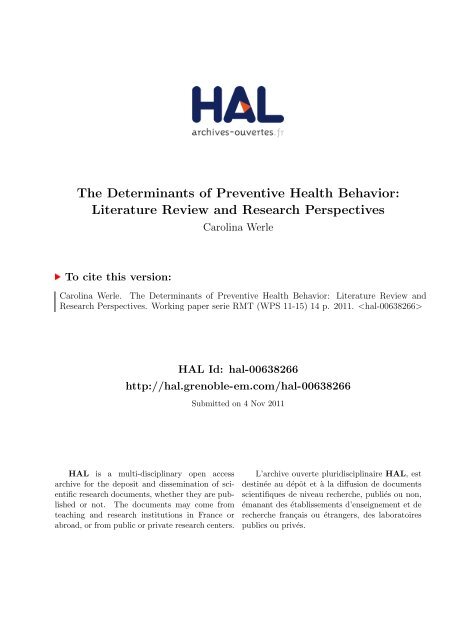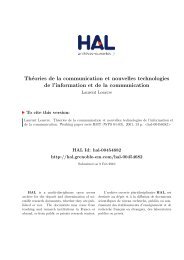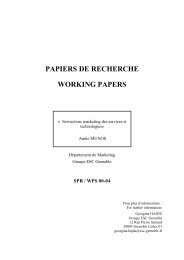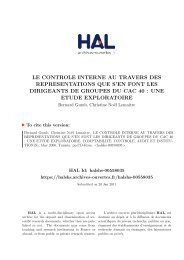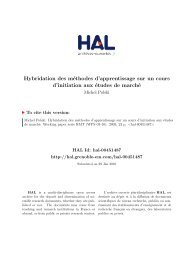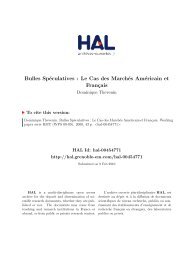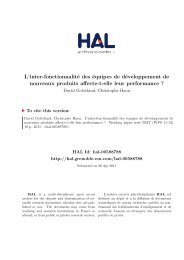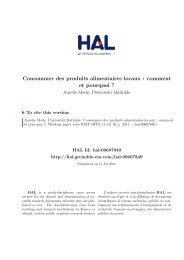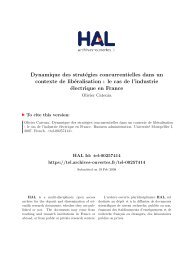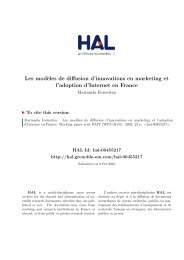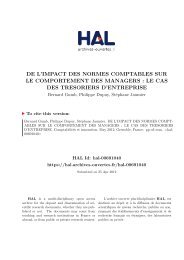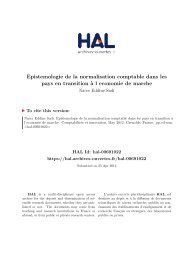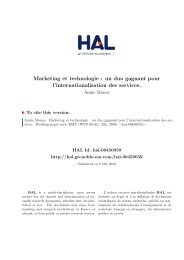The Determinants of Preventive Health Behavior: Literature Review ...
The Determinants of Preventive Health Behavior: Literature Review ...
The Determinants of Preventive Health Behavior: Literature Review ...
Create successful ePaper yourself
Turn your PDF publications into a flip-book with our unique Google optimized e-Paper software.
<strong>The</strong> <strong>Determinants</strong> <strong>of</strong> <strong>Preventive</strong> <strong>Health</strong> <strong>Behavior</strong>:<br />
<strong>Literature</strong> <strong>Review</strong> and Research Perspectives<br />
Carolina Werle<br />
To cite this version:<br />
Carolina Werle. <strong>The</strong> <strong>Determinants</strong> <strong>of</strong> <strong>Preventive</strong> <strong>Health</strong> <strong>Behavior</strong>: <strong>Literature</strong> <strong>Review</strong> and<br />
Research Perspectives. Working paper serie RMT (WPS 11-15) 14 p. 2011. <br />
HAL Id: hal-00638266<br />
http://hal.grenoble-em.com/hal-00638266<br />
Submitted on 4 Nov 2011<br />
HAL is a multi-disciplinary open access<br />
archive for the deposit and dissemination <strong>of</strong> scientific<br />
research documents, whether they are published<br />
or not. <strong>The</strong> documents may come from<br />
teaching and research institutions in France or<br />
abroad, or from public or private research centers.<br />
L’archive ouverte pluridisciplinaire HAL, est<br />
destinée au dépôt et à la diffusion de documents<br />
scientifiques de niveau recherche, publiés ou non,<br />
émanant des établissements d’enseignement et de<br />
recherche français ou étrangers, des laboratoires<br />
publics ou privés.
<strong>The</strong> <strong>Determinants</strong> <strong>of</strong> <strong>Preventive</strong> <strong>Health</strong> <strong>Behavior</strong>: <strong>Literature</strong> <strong>Review</strong> and Research Perspectives<br />
Carolina Obino Corrêa WERLE<br />
Introduction<br />
People normally know they should follow a few preventive health behaviors in order to have a<br />
better and long life: to not smoke, to have a balanced diet low in fat and rich in vegetables and fruits,<br />
to exercise regularly, to avoid heavy drinking, to take medical screens for dangerous diseases, to have<br />
immunizations and to use seatbelts while driving. But even knowing that these measures can prevent<br />
serious future problems, some people do not adopt them. From a managerial and academic standpoint,<br />
it is important to understand the factors behind why people develop preventive health behaviors such<br />
as those cited above. On one hand, this is a primary question for public health when major diseases<br />
could be avoided by such simple actions. In addition, scant attention has been paid to this subject in<br />
the marketing literature in France.<br />
<strong>Preventive</strong> health behaviors have been defined as “any activity undertaken by a person who<br />
believes himself to be healthy for the purpose <strong>of</strong> preventing disease… in an asymptomatic stage”<br />
(Kasl and Cobb 1966, p. 246). As such, they do not provide the same response as health behaviors<br />
developed to treat diseases that have already been diagnosed through symptoms, exams or medical<br />
opinion. <strong>The</strong>refore, the decision to develop preventive health behavior is based on other factors which<br />
are less objective than those symptoms or formal diagnoses given by a doctor. Furthermore, several<br />
preventive health behaviors present advantages not easily accessible in the short term (like the effects<br />
<strong>of</strong> a balanced diet in cholesterol levels, obesity and heart disease prevention), while its costs impact<br />
the consumer’s life directly (i.e., the control <strong>of</strong> sugar or fat consumption through following a balanced<br />
diet).<br />
Several models have been created in order to explain whether people develop preventive<br />
health behaviors or not. Many <strong>of</strong> them are social cognition models which consider that people engage<br />
in preventive health behaviors after: the analysis <strong>of</strong> its consequences, an assessment <strong>of</strong> the disease’s<br />
perceived risk, and an evaluation <strong>of</strong> self-efficacy, e.g. personal capability to develop the target<br />
behavior (Bandura, 1989). Much research has shown that self-efficacy is the main determinant <strong>of</strong><br />
preventive health behaviors (Schwarzer, 1992; Schwarzer and Fuchs, 1996). But the impact <strong>of</strong> selfefficacy<br />
on preventive health behaviors may be influenced by other variables such as emotions<br />
associated with previous experiences with the target behavior. For example, a young obese woman<br />
who has had many unsuccessful dieting experiences may have negative emotions associated with the<br />
preventive behavior <strong>of</strong> having a balanced diet. Will these negative emotions linked to previous dieting<br />
experiences influence her perceived ability to follow a balanced diet? This is one <strong>of</strong> the questions that<br />
this article analyzes.<br />
Another factor that may influence the decision to undertake preventive health behaviors are<br />
individual characteristics, such as temporal orientation (Bergadàa, 1990) or future time perspective<br />
1
(Zimbardo and Boyd, 1999; Keough, Zimbardo and Boyd, 1999; Simons and Lens, 2003). According<br />
to Bergadàa’s temporal orientation construct, future-oriented people are more proactive, they seek<br />
change and opportunities <strong>of</strong> personal development, while past-oriented people are more reactive and<br />
resist external stimuli. Future time perspective (FTP, De Volder and Lens, 1982) is very similar to<br />
temporal orientation since it refers to the present anticipation <strong>of</strong> future goals. People with a short FTP<br />
place most <strong>of</strong> their goals in the near future, while people with a long or deep FTP place their goals in<br />
the distant future. Those with an extended FTP are more motivated for their present activities, put<br />
more effort into them, and perform better on subsequent tests (Simons and Lens, 2003, 5). Empirical<br />
evidence has shown that an extended FTP is positively correlated with student’s motivation and<br />
academic performance. <strong>The</strong>re is empirical evidence <strong>of</strong> the importance <strong>of</strong> the Future Time Perspective<br />
construct as a predictor <strong>of</strong> the reported use <strong>of</strong> alcohol, drug and tobacco (Keough, Zimbardo and<br />
Boyd, 1999). <strong>The</strong>refore, the individual’s time perspective may also influence the adoption <strong>of</strong> other<br />
health behaviors, such as preventive health behaviors. We may thus suppose that future-oriented<br />
people (or people with an extended FTP) will be more prone to develop preventive health behaviors<br />
than past-oriented people (or people with a short FTP).<br />
Nevertheless, people may engage in preventive health behaviors not only for health reasons.<br />
<strong>The</strong>y may develop such behaviors according to their desires (Reach, 2003), in order to respond to<br />
other motivations such as ego-related or socially oriented ones (Jayanti and Burns, 1998). <strong>The</strong><br />
influence <strong>of</strong> motivations not directly linked to health in the decision to engage in preventive health<br />
behaviors is a subject that requires further research.<br />
This article investigates the role <strong>of</strong> emotions associated with past experience, ego-motivations<br />
and individual’s time perspective on preventive health behavior. <strong>The</strong> objective is to propose a model<br />
exploring the influence <strong>of</strong> each one <strong>of</strong> these variables on key predictors <strong>of</strong> preventive behaviors as<br />
self-efficacy, perceived risk and outcome expectancies. To do so, we first analyze preventive health<br />
behavior models from cognitive psychology, clinical psychology and behavioral medicine. We then<br />
propose a model integrating variables that have been neglected by current literature on this subject.<br />
Finally, we propose a research framework to test this model.<br />
<strong>Literature</strong> review<br />
<strong>Preventive</strong> health behaviors have been treated by different fields <strong>of</strong> study. Cognitive and<br />
clinical psychology and behavioral medicine have long tried to explain why people engage in this kind<br />
<strong>of</strong> behavior. Below we shall chronologically present the main models used by scholars to explain<br />
preventive health beliefs.<br />
2
Cognitive Psychology<br />
<strong>The</strong> main social cognition models used to explain preventive health behaviors - the <strong>Health</strong><br />
Belief Model (HBM) (Rosenstock, 1974; Janz and Becker, 1984), the Protection Motivation <strong>The</strong>ory<br />
(PMT) (Rogers, 1975, 1983), the <strong>The</strong>ory <strong>of</strong> Reasoned Action (TRA) and the <strong>The</strong>ory <strong>of</strong> Planned<br />
<strong>Behavior</strong> (TPB) (Ajzen and Fishbein, 1980; Azjen, 1985, 1991) – have the same conceptual basis: the<br />
theory <strong>of</strong> subjective expected utility (SEU theory). <strong>The</strong>y consider that when making a decision, a<br />
person will analyze the positive and negative potential consequences <strong>of</strong> each option using a rational<br />
decision rule.<br />
<strong>The</strong> <strong>Health</strong> Belief Model (HBM) (Rosenstock, 1974; Janz and Becker, 1984) is one <strong>of</strong> the<br />
most commonly-used models <strong>of</strong> health behavior change used to guide the development <strong>of</strong> health<br />
interventions. It was developed in the early 1950’s as a framework for promoting preventive behaviors<br />
(such as immunizations) (Janz & Becker, 1984) and it considers that people will act to protect their<br />
health if they perceive that they are at risk and that a particular action will enable them to deal with<br />
such a risk, without triggering excessive personal sacrifice.<br />
Briefly, the HBM suggests that preventive health behaviors are influenced by five factors: 1)<br />
Perceived susceptibility – one’s subjective perception <strong>of</strong> the risk <strong>of</strong> contracting a condition; 2)<br />
Perceived severity – perceptions concerning the seriousness <strong>of</strong> the illness if it is contracted or left<br />
untreated; 3) Perceived benefits – beliefs regarding the effectiveness <strong>of</strong> the actions available in<br />
reducing the threat <strong>of</strong> the disease; 4) Perceived barriers – the potentially negative aspects <strong>of</strong> a<br />
particular health action (e.g., physical, psychological and financial aspects: side effects, pain, timeconstraint<br />
and expense) and 5) Cues to action – reminders about a potential health problem (e.g.,<br />
newspaper and magazine article, mass media campaigns, advice from others). It should be noted that<br />
cues to action can be external (e.g., the recommendation <strong>of</strong> a physician or mass media messages) or<br />
internal (e.g., symptoms), but in the case <strong>of</strong> preventive health behaviors only external cues to action<br />
are relevant, because there are no symptoms. According to the HBM, individuals consider the<br />
potential benefits <strong>of</strong> the recommended response against the barriers <strong>of</strong> the action when deciding to act.<br />
Several health interventions and research projects have used the HBM as a conceptual basis,<br />
even if the model presents some significant limitations. <strong>The</strong> main HBM limit is the assumption that<br />
beliefs will directly impact behavior. Further research (see Protection Motivation <strong>The</strong>ory, <strong>The</strong>ory <strong>of</strong><br />
Reasoned Action and <strong>The</strong>ory <strong>of</strong> Planned <strong>Behavior</strong> for more details) has proven that attitude mediates<br />
this relation and is the best predictor <strong>of</strong> behavior, increasing the model’s explained variance (Oliver<br />
and Berger, 1979). Further, the HBM proposes a simple list <strong>of</strong> variables, intervening at the same time<br />
and with the same importance in the decision to engage in a target behavior. Other models have<br />
suggested a sequential order: before the preventive action evaluation (perceived benefits and<br />
perceived costs <strong>of</strong> preventive action), people evaluate the threat at hand through perceived severity<br />
<strong>of</strong> the disease and perceived personal susceptibility (see Protection Motivation <strong>The</strong>ory for details).<br />
3
Finally, the HBM core assumption (based on SEU theory) that people rationally evaluate<br />
potential consequences and benefits <strong>of</strong> a behavior neglects significant subjective aspects such as<br />
emotions, decisional biases and situational factors that have been proven to impact preventive health<br />
behavior (Oliver and Berger, 1979; Burns, 1992; Moorman and Matulich, 1993; Jayanti and Burns,<br />
1998; Kahn, 2003).<br />
Furthermore, the <strong>Health</strong> Belief Model does not take into account the role <strong>of</strong> past experiences<br />
with the target behavior. Direct or indirect previous experiences with the preventive health behavior<br />
are taken into account only through variables such as perceived barriers or perceived benefits <strong>of</strong> the<br />
behavior. If we consider the emotions associated with past behaviors to be strong, they may directly<br />
impact the future adhesion to the target behavior. This aspect is neglected by the <strong>Health</strong> Belief Model.<br />
<strong>The</strong> Protection Motivation <strong>The</strong>ory (PMT) (Rogers, 1975) was originally proposed to<br />
provide conceptual clarity to the understanding <strong>of</strong> fear appeals. A later revision <strong>of</strong> Protection<br />
Motivation <strong>The</strong>ory (Rogers, 1983) extended the model to a more general theory <strong>of</strong> persuasive<br />
communication, with an emphasis on the cognitive processes mediating behavioral change.<br />
<strong>The</strong> PMT proposes that the intention to protect oneself depends upon four factors: 1) the<br />
perceived severity <strong>of</strong> a threatened event – seriousness <strong>of</strong> a disease; 2) the perceived vulnerability –<br />
chance <strong>of</strong> contracting a disease; 3) the efficacy <strong>of</strong> the recommended preventive behavior – the<br />
perceived response efficacy: the analysis <strong>of</strong> benefits and barriers associated with the preventive health<br />
behavior; and 4) the perceived self-efficacy – e.g., the level <strong>of</strong> confidence in one’s ability to undertake<br />
the recommended preventive behavior (Bandura, 1989).<br />
Protection motivation is the result <strong>of</strong> the threat appraisal and the coping appraisal. Threat<br />
appraisal is the estimation <strong>of</strong> the chance <strong>of</strong> contracting a disease (vulnerability) and estimates <strong>of</strong> the<br />
seriousness <strong>of</strong> a disease (severity). Coping appraisal is an evaluation <strong>of</strong> one’s ability to face the<br />
threat through an action (response efficacy) and through his or her personal ability to carry out this<br />
action (self-efficacy). Protection motivation is a mediating variable whose function is to arouse,<br />
sustain and direct protective health behavior (Boer and Seydel, 1996). According to Prentice-Dunn<br />
and Rogers (1986) this variable has the role <strong>of</strong> an attitudinal variable, and is normally assessed<br />
through attitudinal measures, even if the label – protection motivation – is different.<br />
<strong>The</strong> PMT is quite similar to the HBM. First <strong>of</strong> all, both theories have the same basis.<br />
Furthermore, the PMT takes into account all the dimensions <strong>of</strong> the HBM: it directly assesses perceived<br />
severity and perceived susceptibility. <strong>The</strong> response efficacy summarizes the effects <strong>of</strong> two variables in<br />
the HBM: the barriers and the benefits <strong>of</strong> the preventive health behavior. <strong>The</strong> difference is located in<br />
the way these variables are assessed. <strong>The</strong> PMT proposes that people evaluate a preventive health<br />
behavior through two sequential processes: the threat appraisal and the coping appraisal. Next, PMT<br />
takes into account perceived self-efficacy, a variable neglected by the HBM, where it is only measured<br />
indirectly through the variable <strong>of</strong> perceived barriers against the preventive behavior.<br />
4
However, the PMT’s premise that perceived severity, perceived vulnerability, response<br />
efficacy and perceived self-efficacy are equally important in determining behavioral intentions has<br />
been proved to be inadequate (Block and Keller, 1998). <strong>The</strong>y suggest that people at different stages <strong>of</strong><br />
readiness to change their behavior are differentially affected by levels <strong>of</strong> these variables.<br />
At the same time that PMT was created, a more general theory was developed in order to<br />
investigate the relationship between attitudes and behaviors: the <strong>The</strong>ory <strong>of</strong> Reasoned Action (TRA)<br />
(Ajzen and Fishbein, 1980). This theory is based on the principle <strong>of</strong> compatibility (Ajzen, 1980). This<br />
principle states that each attitude and behavior has the four elements <strong>of</strong> 1) action, 2) target, 3) context<br />
and 4) time, and states that the correspondence between attitudes and behaviors will be greatest when<br />
both are measured at the same level with respect to each <strong>of</strong> these elements. Following this principle,<br />
attitude is the best predictor <strong>of</strong> behavior.<br />
According to the TRA (Fishbein and Ajzen, 1980), two sets <strong>of</strong> beliefs must be altered prior to<br />
behavioral change: beliefs about the consequences <strong>of</strong> performing a certain behavior and the evaluation<br />
<strong>of</strong> those consequences (attitude); and beliefs about what other people or referents think about the<br />
behavior to be performed and the motivation to comply with those referents (subjective norm). Only<br />
when a message targets the salient beliefs <strong>of</strong> these variables do attitudes and subjective norms change,<br />
and in consequence there is an alteration <strong>of</strong> intentions and behavior.<br />
<strong>The</strong> <strong>The</strong>ory <strong>of</strong> Planned <strong>Behavior</strong> (TPB) (Azjen, 1985, 1991) was developed in order to<br />
cover a limit <strong>of</strong> the TRA concerning the control people have over their behaviors. To do so, an extra<br />
dimension was included in the model – the perceived behavioral control. This construct is especially<br />
important in situations where people do not control their behaviors due to intervening environmental<br />
conditions. Perceived <strong>Behavior</strong>al Control is determined by two factors: Control Beliefs and Perceived<br />
Power. It indicates how a person's motivation is influenced by how difficult the behaviors are<br />
perceived to be, as well as the perception <strong>of</strong> how successfully the individual can, or cannot, perform<br />
the activity. This construct is quite similar to the notion <strong>of</strong> self-efficacy (Bandura, 1989).<br />
In summary, according to the TPB when a person considers the decision to adopt a balanced<br />
diet, for example, he or she will analyze the potential consequences <strong>of</strong> this behavior (i.e., lose<br />
weight in the long term and change dietary habits in the short term) and these perceptions will be<br />
reflected in an attitude towards the behavior. In addition, the person will also analyze what other<br />
people will think about the fact that he or she will be dieting and his or her willingness to comply with<br />
these opinions (subjective norm). Finally, the perceived behavioral control will indicate the<br />
difficulty to perform the behavior (ease or difficulty in following the diet). <strong>The</strong>se three elements will<br />
determine the intention to comply with a diet, and it follows that this intention will directly influence<br />
the behavior.<br />
Despite the great contribution <strong>of</strong> the TPB to the understanding <strong>of</strong> preventive health behaviors,<br />
it nevertheless presents some intrinsic limitations. First, the model deals with perceptions <strong>of</strong> control<br />
5
and not with actual control, so elements may exist but may not be taken into account in the<br />
individual’s perception <strong>of</strong> control. Second, this model neglects variables that may interfere with the<br />
link between attitude and behavior, such as situational factors. Third, the TPB, as well as other models<br />
presented previously, does not consider the direct effect <strong>of</strong> emotional responses associated with past<br />
experiences. Finally, the model does not consider the influence <strong>of</strong> individual characteristics on the<br />
decision to engage in preventive health behavior.<br />
Much research has attempted to compare social cognitive models and has come up with mixed<br />
results. Oliver and Berger (1979) compared the HBM with the TRA and found that the TRA was a<br />
stronger predictor <strong>of</strong> inoculation behavior. Hill et al. (1985) also compared these two models in order<br />
to identify the determinants <strong>of</strong> women’s intentions to perform breast self-examination and to have a<br />
pap test. Both models predict the intentions to perform target behaviors, but the HBM explained more<br />
variance (probably because the authors measured more constructs <strong>of</strong> the HBM than <strong>of</strong> the TRA).<br />
Mullen et al. (1987) also compared the HBM and the TRA in order to predict changes in a range <strong>of</strong><br />
health behaviors over an eight-month period, and showed that the HBM explained more variance.<br />
However, Rutter (1989) showed that the TRA was superior to the HBM when predicting AIDSpreventive<br />
behavior. Conner and Norman (1994) examined the determinants <strong>of</strong> attendance to a routine<br />
health check-up and found that both models had the same predictive power. In sum, there is no<br />
unanimity concerning the comparison between the TRA and the HBM and comparative research<br />
indicates that both models measure similar constructs.<br />
Through an analysis <strong>of</strong> the HBM, the PMT, the TRA and the TPB we identify six main<br />
determinants <strong>of</strong> preventive health behavior: perceived vulnerability and perceived severity (forming<br />
the threat appraisal dimension), perceived benefits, perceived barriers and self-efficacy (forming the<br />
coping appraisal dimension), and the subjective norm. According to Floyd, Prentice-Dunn and<br />
Rogers (2000) and Janz and Becker (1984), the variables having greater predictive power are the<br />
coping ones: coping appraisal variables (perceived benefits and barriers to develop the target<br />
behavior) and self-efficacy. <strong>The</strong> HBM also points out that cues to action may influence preventive<br />
behavior, while the PMT assumes that sources <strong>of</strong> information will influence the individual’s<br />
response. <strong>The</strong> main dependent variable is the preventive behavior, but the relation between the<br />
determinants and this variable is mediated by the attitude towards the preventive health behaviors,<br />
that is its main predictor.<br />
Clinical Psychology<br />
Research in Clinical Psychology has also attempted to explain the adoption <strong>of</strong> preventive<br />
health behaviors. <strong>The</strong> Transtheoretical Model (DiClemente and Prochaska, 1982) is based on the<br />
analysis <strong>of</strong> behavioral change in clinical psychology. According to DiClemente and Prochaska (1982)<br />
people change their behavior through six phases:<br />
6
1) Pré-contemplation - stage when people still resist change, deny the problem and have no<br />
intention <strong>of</strong> changing;<br />
2) Contemplation - stage when people assume they have a problem, but do not take any<br />
action to resolve it;<br />
3) Preparation - stage when people plan to take action and prepare themselves to do so<br />
through specific plans;<br />
4) Action - stage when people modify their behavior;<br />
5) Maintenance - stage when people reinforce the preventive behavior over time and<br />
6) Terminance – stage when it is clear that the problem will not return and is not a threat<br />
anymore.<br />
Linear progression through the stages may occur, but people normally cycle and recycle back<br />
several times. In each phase different beliefs need to be reinforced in order to allow behavioral change.<br />
This model is especially pertinent to study preventive behaviors that are developed over the<br />
long term such as dieting, exercising and to quit smoking because it takes into account the temporal<br />
dimension <strong>of</strong> behavioral change. Some research has used this model to analyze health-related<br />
behaviors such as smoking cessation, alcohol abuse, AIDS risk reduction, exercise adoption and others<br />
(Block and Keller, 1998; DiClemente and Prochaska, 1985; Prochaska and DiClemente, 1982;<br />
Prochaska, Norcross and al., 1994; Prochaska, Redding, Harlow, Rossi and Velicer, 1994).<br />
Even if there are some empirical studies that use the Transtheoretical Model, it remains a<br />
relatively unexplored framework that needs further elaboration and empirical applications (Norman<br />
and Conner, 1996). <strong>Behavior</strong>al change takes place over time and is normally not only an isolated<br />
event. <strong>The</strong>refore, the influence <strong>of</strong> each cognitive variable during each stage may be further explored in<br />
order to provide elements to intervene in each phase.<br />
<strong>Behavior</strong>al Medicine<br />
Besides clinical and cognitive psychology, behavioral medicine has also tried to identify<br />
determinants <strong>of</strong> preventive health care behavior. Reach (2003) proposes a philosophical approach and<br />
suggests that people decide to engage or not in health behaviors according to their desires (Reach<br />
analyzed health behaviors in general, including preventive health behaviors). <strong>The</strong>refore, a person may<br />
develop a preventive health behavior such as dieting not because it’s better for his/her cholesterol<br />
control, but because he/she wants to improve personal appearance and considers that this action will<br />
help achieve this goal. As opposed to the majority <strong>of</strong> socio cognitive models, this author suggests the<br />
importance <strong>of</strong> emotional factors behind health behaviors.<br />
Reach (2003) and Jayanti and Burns (1998) point out the importance <strong>of</strong> other reasons for<br />
developing preventive behaviors – i.e., following a balanced diet to improve personal appearance<br />
7
ather than for general health reasons or exercising frequently to be socially accepted. I contend that a<br />
key to developing compliance towards preventive health behaviors can be found through reinforcing<br />
ego-motivations or social motivations naturally associated with target behaviors. <strong>The</strong>se motivations<br />
may also influence the adhesion to preventive health behaviors, and their importance in comparison to<br />
health motivations may be assessed through further research.<br />
Integrative Model<br />
Some research has tried to integrate social cognitive models and the process approach<br />
proposed by stage models aforementioned. It is the case <strong>of</strong> the HAPA – the <strong>Health</strong> Action Process<br />
Approach (Schwarzer, 1992). This model considers that the adoption, initiation and maintenance <strong>of</strong><br />
health behaviors must be conceived as a process with at least two stages: a motivation phase and a<br />
volition phase (subdivided into a planning phase, an action phase and a maintenance phase)<br />
(Schwarzer and Fuchs, 1996). Self-efficacy influences both phases while other beliefs will influence<br />
only one <strong>of</strong> them: perceived risk influences only in the moment that people will progress from the<br />
contemplation to the motivation phase, while outcome expectancies influences occur during the<br />
motivation phase only.<br />
Self-efficacy, perceived risk and outcome expectancies will influence the intention to perform<br />
the health behavior. When this intention takes form, and before actual behavior takes place, there is a<br />
planning stage during which people will develop action plans. Self-efficacy, external barriers and<br />
resources, and self-referent thought will influence this phase. <strong>The</strong> following figure summarizes the<br />
HAPA:<br />
Outcome<br />
expectancies<br />
Perceived<br />
Self-efficacy<br />
Risk<br />
perceptions<br />
Goal intentions Action plans Action control<br />
Volitional<br />
process<br />
<strong>Health</strong> action<br />
perceived<br />
actual<br />
External barriers, resources<br />
& social support<br />
<strong>The</strong> health action process approach (adapted from Schwarzer, 1992, 233)<br />
Empirical evidence confirms the importance <strong>of</strong> this model. Schwarzer and Fuchs (1996) tested the<br />
model in a survey with 800 Berliners (Germany). This research was made in two waves with a 6<br />
months interval between the two. In the first wave the following variables were measured:<br />
Self-efficacy<br />
8
Positive outcome expectancies<br />
Negative outcome expectancies<br />
Risk perception<br />
Previous healthy eating behavior<br />
Intention to eat healthy foods (dependent variable)<br />
In the first wave, self-efficacy accounted for 16% <strong>of</strong> the intention’s variance. For the second wave,<br />
the intention to eat healthy foods was added as a predictor <strong>of</strong> self-reported health behavior during the<br />
preceding six months. Results (reported in the table below) indicate differences by gender. Intention<br />
was the best predictor for men (0.24) while self-efficacy was the best predictor for women (0.28).<br />
Table: Prediction <strong>of</strong> healthy eating behavior half a year later (wave 2)<br />
Predictor Men (n = 353)<br />
Beta<br />
Women (n = 462)<br />
Intention to eat healthy foods 0.24** 0.12*<br />
Risk perception 0.07 -0.01<br />
Self-efficacy 0.23** 0.28**<br />
Positive outcome expectancy 0.19** 0.19**<br />
Negative outcome expectancy 0.01 -0.10*<br />
Risk perception X Self-efficacy -0.07 -0.05<br />
Positive outcome expectancy X Self-efficacy -0.03 0.02<br />
Negative outcome expectancy X Self-efficacy 0.00 -0.01<br />
Positive outcome expectancy X risk perception 0.03 0.02<br />
Negative outcome expectancy X risk perception -0.08 -0.02<br />
* path coefficient significant at p < 0.05; ** p < 0.01<br />
(Schwarzer and Fuchs, 1996 )<br />
R = 0.48<br />
(Adj R² = 0.21)<br />
Beta<br />
R = 0.47<br />
(Adj R² = 0.20)<br />
<strong>The</strong>se results suggest that respondent’s gender moderates the self-efficacy influence towards<br />
behavior. Further research about this model (Schwarzer and Renner, 2000) indicates that other<br />
individual characteristics may also influence this relationship. Schwarzer and Renner (2000) replicated<br />
the previous study and added an extra variable: the coping self-efficacy, or the post-intentional selfefficacy.<br />
Following the same design from Schwarzer and Fuchs (1996) (n = 580, 2 waves, with a 6-<br />
month interval), risk perceptions, outcome expectancies and action self-efficacy were specified as<br />
predictors <strong>of</strong> intention in the first wave. <strong>Behavior</strong>al intention and coping self-efficacy served as<br />
mediators linking the three predictors in wave one, with self-reported nutrition behaviors in wave two.<br />
<strong>The</strong> model was analyzed through covariance structure analysis and a good fit was obtained.<br />
Differences by age and weight emerged, confirming that individual characteristics may moderate the<br />
impact <strong>of</strong> self-efficacy on behavior. This disparity <strong>of</strong> individual characteristics provides precisely a<br />
starting point for future research that I propose to carry out in further detail.<br />
Discussion<br />
We have thus far analyzed the main models created in order to explain preventive health<br />
behaviors. Even if these models have brought about important contributions to the understanding <strong>of</strong><br />
9
these behaviors, they do not explain the totality <strong>of</strong> this phenomenon (the variance explained remains<br />
minor), and there are still some avenues <strong>of</strong> research that should be developed. For example:<br />
Past experiences influence self-efficacy perceptions (Schwarzer, 1992; Schwarzer and Fuchs,<br />
1996; Norman and Conner, 1996) but there is a need for further clarification on this influence. In a<br />
study about mammography false-alarm tests, Kahn and Luce (2003) demonstrated that negative<br />
experience with the preventive health behavior in question generates stress and negatively impacts<br />
future adherence to this behavior. <strong>The</strong>refore, we could hypothesize that positive or negative emotions<br />
associated with these past experiences could differently influence self-efficacy beliefs. Positive<br />
emotions associated with past experience will positively influence self-efficacy beliefs, thus enhancing<br />
self-efficacy. For instance, if we analyze the decision to start exercising regularly and the individual<br />
has positive feelings associated with his or her past experiences with it (he or she had a good moment,<br />
had a good performance in exercising…), we may suppose that he or she will feel more able to<br />
exercise regularly in the future. Inversely, when the person has negative feelings associated with past<br />
exercise experience, his or her perceived self-efficacy could be diminished.<br />
<strong>The</strong> same rule applies to outcome expectancies. Emotions associated with past experiences<br />
may also influence outcome expectancies, since the person will judge the results he or she could<br />
obtain from the target behavior according to his or her past experiences and the emotions associated<br />
with them. Positive emotions associated with past experiences will positively influence outcome<br />
expectancies, and inversely negative emotions associated with past experiences will negatively<br />
influence outcome expectancies 1 . This is the first response to a gap in current research that I am<br />
proposing to fill in my current research (Doctoral Dissertation – estimated completion 2007).<br />
As mentioned earlier, individuals’ temporal orientation, which is essentially another name for<br />
Future Time Perspective (FTP), may influence the self-efficacy construct 2 . I contend that temporal<br />
orientation or FTP, will moderate the impact <strong>of</strong> self-efficacy on preventive health behaviors. For<br />
future-oriented people or those with an extended FTP, self-efficacy beliefs will positively impact<br />
intentions and behavior, while for past-oriented people (or those with a short FTP) the impact will be<br />
negative, given that they do not anticipate long term benefits. This leads to my second response to<br />
another unexplored area in current research.<br />
Even if individual characteristics may moderate the relationship between self-efficacy and<br />
preventive health behaviors, the third and final factor that merits further study is the motivation behind<br />
preventive behaviors. Ego-related motivations are those not directly related to health outcomes but that<br />
may be achieved through preventive health behaviors. Examples may include personal appearance or<br />
1 If we consider the example <strong>of</strong> regular exercise, the person having negative emotions associated with past exercise experience will probably<br />
expect to have continued negative outcomes from this target behavior.<br />
2 According to Bergadàa (1990) future-oriented people are more proactive, seek change and opportunities <strong>of</strong> personal development.<br />
Likewise, people with an extended FTP present the same characteristics (Zimbardo and Boyd, 1997; Keough, Zimbardo and Boyd, 1999;<br />
Simons and Lens, 2003).<br />
10
group acceptance motivations. I assert that people develop preventive health behaviors motivated by<br />
non-health reasons. In addition, ego-related motivations may also influence outcome expectancies, and<br />
individuals following ego-related motivations may in turn reinforce positive consequences influencing<br />
preventive behavior. Furthermore, as stated earlier, ego-related motivations may directly impact the<br />
attitude towards a preventive behavior. In this case, preventive health behavior is motivated only by<br />
ego-related motivations that may short-cut cognitive processes and may directly assess attitudes<br />
towards the behavior, characterizing a spontaneous processing model (Fazio, 1990).<br />
<strong>The</strong> following figure summarizes the hypothetical relationships.<br />
Ego-related<br />
motivations**<br />
Emotions<br />
associated with<br />
past experience<br />
with the PHB**<br />
Perceived risk*<br />
Outcome<br />
expectancies*<br />
Self-efficacy*<br />
Attitude*<br />
Intentions and<br />
action plans*<br />
Action*<br />
Stage:<br />
Motivation stage*<br />
Planning stage*<br />
Action*<br />
Individuals’ temporal<br />
orientation**<br />
* Aforementioned research; ** proposed research avenues.<br />
Further exploratory research will allow us to verify the importance <strong>of</strong> the proposed variables<br />
with regards to the decision to engage in preventive health behaviors. This will be useful in identifying<br />
the main ego-related motivations that enable preventive behaviors. Finally, this research will review<br />
other significant individual characteristics whose relation to and impact on self efficacy and preventive<br />
behaviors have up until now not been revealed.<br />
References<br />
Azjen I. (1985), From intentions to actions: a theory <strong>of</strong> planned behavior, in J. Kuhl and J. Beckman<br />
(eds), Action-control: From cognition to behavior, Heidelberg, Springer, 11-39.<br />
Azjen I. (1991), <strong>The</strong> theory <strong>of</strong> planned behavior, Organizational <strong>Behavior</strong> and Human Decision<br />
Processes, 50, 179-211.<br />
Ajzen I. and Fishbein M. (1980), Understanding Attitudes and Predicting Social Behaviour,<br />
Englewood Cliffs, N.J.: Prentice Hall.<br />
11
Bandura, A. (1989), Perceived self-efficacy in the exercise <strong>of</strong> control over AIDS infection, in V.M.<br />
Mays, G.W. Albee, S.S. Schneider (Eds.), Primary prevention <strong>of</strong> AIDS: Psychological Approaches,<br />
Newbury Park, CA, Sage, 128-141.<br />
Bergadàa M.M. (1990), <strong>The</strong> role <strong>of</strong> time in the action <strong>of</strong> the consumer, Journal <strong>of</strong> Consumer<br />
Research, 17, 4, 289-302.<br />
Block L.G. and Keller P.A. (1998), Beyond Protection Motivation: an integrative theory <strong>of</strong> health<br />
appeals, Journal <strong>of</strong> Applied Social Psychology, 28, 17, 1584-1608.<br />
Boer H. and Seydel E.R. (1996), Protection Motivation <strong>The</strong>ory, in M. Conner and P. Norman (eds),<br />
Predicting <strong>Health</strong> Behaviour, Buckingham, Philadelphia, Open University Press, 95-120.<br />
Burns A.C. (1992), <strong>The</strong> expanded HBM as a basis for enlightened preventive health care practice and<br />
research, JHCM, 12, 3, 32-45.<br />
Conner P. and Norman P. (1996)(éds), Predicting <strong>Health</strong> <strong>Behavior</strong>s, Buckingham, Grande Bretagne,<br />
Open University Press.<br />
De Volder M. and Lens W. (1982), Academic achievement and future time perspective as a cognitivemotivational<br />
concept, Journal <strong>of</strong> Personality and Social Psychology, 42, 566-571.<br />
DiClemente C.C. and Prochaska J.O. (1982), Self-change and therapy change <strong>of</strong> smoking behavior: a<br />
comparison <strong>of</strong> processes change in cessation and maintenance, Addictive <strong>Behavior</strong>s, 7, 133-142.,<br />
DiClemente C.C. and Prochaska J.O. (1985), Processes and stages <strong>of</strong> change: Coping and competence<br />
in smoking behavior change, in Shiffman S. and Wills T.A. (eds), Coping and substance abuse, New<br />
York, NYC: Academic, 319-344.<br />
Floyd D.L., Prentice-Dunn S. and Rogers R.W. (2000), A meta-analysis <strong>of</strong> research on protection<br />
motivation theory, Journal <strong>of</strong> Applied Social Psychology, 30, 2, 407-430.<br />
Janz N.K. and Becker M.H. (1984), <strong>The</strong> <strong>Health</strong> Belief Model: a decade later, <strong>Health</strong> Education<br />
Quaterly, 11, November, 1-47.<br />
Jayanti R.K. and Burns A.C. (1998), <strong>The</strong> antecedents <strong>of</strong> preventive health care behavior, Journal <strong>of</strong><br />
the Academy <strong>of</strong> Marketing Science, 26, 1, 6-15.<br />
Kahn B.E. and Luce M.F. (2003), Understanding High-Stakes Consumer Decisions: mammography<br />
adherence following false-alarm test results, Marketing Science, 22, 3, 393-410.<br />
Kasl and Cobb (1966), <strong>Health</strong> <strong>Behavior</strong>, Illness <strong>Behavior</strong> and Sick Role <strong>Behavior</strong>, Archives <strong>of</strong><br />
Environmental <strong>Health</strong>, 12, February, 246-66.<br />
Keough K.A., Zimbardo P.G. and Boyd J.N. (1999), Who’s smoking, drinking and using drugs? Time<br />
Perspective as a Predictor <strong>of</strong> Substance Use, Basic and Applied Social Psychology, 21, 2, 149-164.<br />
12
Moorman C. and Matulich E. (1993), A model <strong>of</strong> consumers’ health behaviours: the role <strong>of</strong> health<br />
motivation and health ability, Journal <strong>of</strong> Consumer Research, 20, September, 208-228.<br />
Oliver R.L. and Berger P. K. (1979), A path analysis <strong>of</strong> preventive health care decision models,<br />
Journal <strong>of</strong> Consumer Research, 6, 113-122.<br />
Prochaska J.O. and DiClemente C.C. (1982), Transtheoretical therapy: Toward a more integrative<br />
model <strong>of</strong> change, Psychoterapy: <strong>The</strong>ory, Research and Practice, 19, 3, 276-288.<br />
Prochaska J.O. and DiClemente C.C. (1983), Stages and processes <strong>of</strong> self-cnage smoking: toward an<br />
integrative model <strong>of</strong> change, Journal <strong>of</strong> Consulting and Clinical Psychology, 51, 390-395.<br />
Prochaska J.O., DiClemente C.C. and Norcross J.C. (1992), In search <strong>of</strong> how people change:<br />
Applications to addictive behaviours, American Psychologist, 47(9), 1102-1114.<br />
Prochaska J.O., Velicer W.F., Guadagnoli E., Rossi J.S., DiClemente C.C. (1991), Patterns <strong>of</strong> Change:<br />
Dynamic Typology Applied to Smoking Cessation, Multivariate <strong>Behavior</strong>al Research, 26, 1, 83-108.<br />
Reach G. (2003), La non-observance thérapeutique, Paris, Le Bord de l’Eau éditions.<br />
Rogers R.W. (1975), A protection motivation theory <strong>of</strong> fear appeals and attitude change, <strong>The</strong> Journal<br />
<strong>of</strong> Psychology, 91, 93-114.<br />
Rogers R.W. (1983), Cognitive and physiological processes in fear appeals and attitude change: A<br />
revised theory <strong>of</strong> protection motivation, in J.T. Cacioppo and R.E Petty (eds), Social<br />
psychophysiology, New York, NY, Guilford, 153-176.<br />
Rosenstock I.M. (1974), <strong>The</strong> <strong>Health</strong> Belief Model and <strong>Preventive</strong> <strong>Health</strong> <strong>Behavior</strong>, <strong>Health</strong> Education<br />
Monographs, 2, 354-368.<br />
Schwarzer R. (1992), Self efficacy in the adoption and maintenance <strong>of</strong> health behaviors: theoretical<br />
approaches and a new model, in Schwarzer R., Self-efficacy: thought control <strong>of</strong> action, Washington,<br />
DC, Hemisphere Publishing Corporation, 217-243.<br />
Schwarzer R. and Fuchs R. (1996), Self-efficacy and health behaviors, in Conner M. And Norman P.<br />
(eds)(1996), Predicting <strong>Health</strong> <strong>Behavior</strong>s, Buckingham, Grande-Bretagne, Open University Press,<br />
161-195<br />
Schwarzer R. and Renner B. (2000), Social-Cognitive Predictors <strong>of</strong> <strong>Health</strong> <strong>Behavior</strong>: Action Self-<br />
Efficacy and Coping Self-Efficacy, <strong>Health</strong> Psychology, 19, 5, 487-495.<br />
Simons J., Vanteenkiste M. and Lens W. (2004), Placing Motivation and Future Time Perspective in a<br />
Temporal Perspective, Educational Psychology <strong>Review</strong>, 16, 2, 121-139.<br />
Zani B. (2002), Théories et modèles en psychologie de la santé, in Traité de psychologie de la santé,<br />
sous la direction de Gustave-Nicolas Fischer, Paris, Dunod, 21-46.<br />
13
Zimbardo P.G. and Boyd J.N. (1999), Putting Time in Perspective: A Valid, Reliable Individual-<br />
Differences Metric, Journal <strong>of</strong> Personality & Social Psychology, 77, 6, 1271-1288.<br />
14


